Page 98 of 661
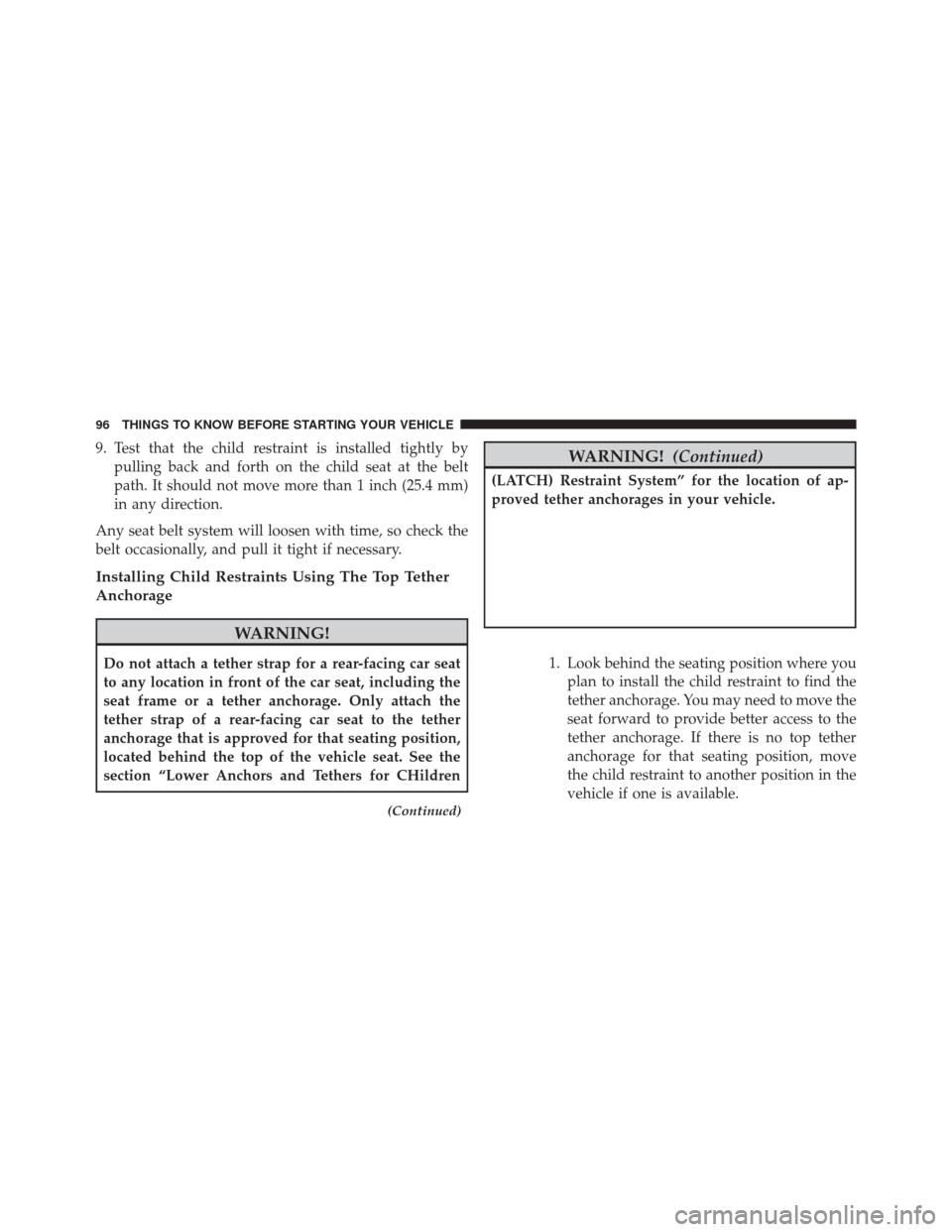
9. Test that the child restraint is installed tightly bypulling back and forth on the child seat at the belt
path. It should not move more than 1 inch (25.4 mm)
in any direction.
Any seat belt system will loosen with time, so check the
belt occasionally, and pull it tight if necessary.
Installing Child Restraints Using The Top Tether
Anchorage
WARNING!
Do not attach a tether strap for a rear-facing car seat
to any location in front of the car seat, including the
seat frame or a tether anchorage. Only attach the
tether strap of a rear-facing car seat to the tether
anchorage that is approved for that seating position,
located behind the top of the vehicle seat. See the
section “Lower Anchors and Tethers for CHildren
(Continued)
WARNING! (Continued)
(LATCH) Restraint System” for the location of ap-
proved tether anchorages in your vehicle.
1. Look behind the seating position where you
plan to install the child restraint to find the
tether anchorage. You may need to move the
seat forward to provide better access to the
tether anchorage. If there is no top tether
anchorage for that seating position, move
the child restraint to another position in the
vehicle if one is available.
96 THINGS TO KNOW BEFORE STARTING YOUR VEHICLE
Page 100 of 661
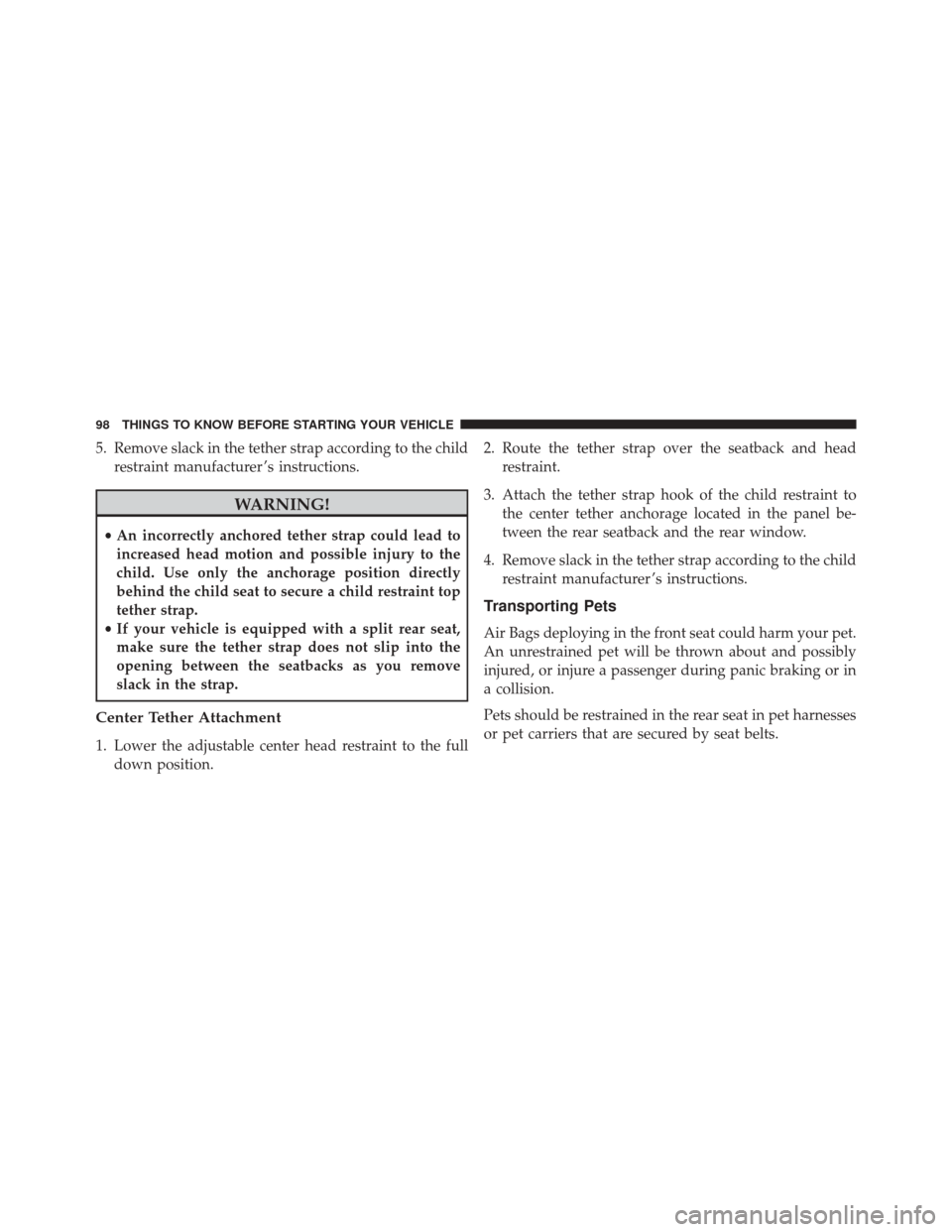
5. Remove slack in the tether strap according to the childrestraint manufacturer ’s instructions.
WARNING!
•An incorrectly anchored tether strap could lead to
increased head motion and possible injury to the
child. Use only the anchorage position directly
behind the child seat to secure a child restraint top
tether strap.
• If your vehicle is equipped with a split rear seat,
make sure the tether strap does not slip into the
opening between the seatbacks as you remove
slack in the strap.
Center Tether Attachment
1. Lower the adjustable center head restraint to the full down position. 2. Route the tether strap over the seatback and head
restraint.
3. Attach the tether strap hook of the child restraint to the center tether anchorage located in the panel be-
tween the rear seatback and the rear window.
4. Remove slack in the tether strap according to the child restraint manufacturer ’s instructions.
Transporting Pets
Air Bags deploying in the front seat could harm your pet.
An unrestrained pet will be thrown about and possibly
injured, or injure a passenger during panic braking or in
a collision.
Pets should be restrained in the rear seat in pet harnesses
or pet carriers that are secured by seat belts.
98 THINGS TO KNOW BEFORE STARTING YOUR VEHICLE
Page 102 of 661
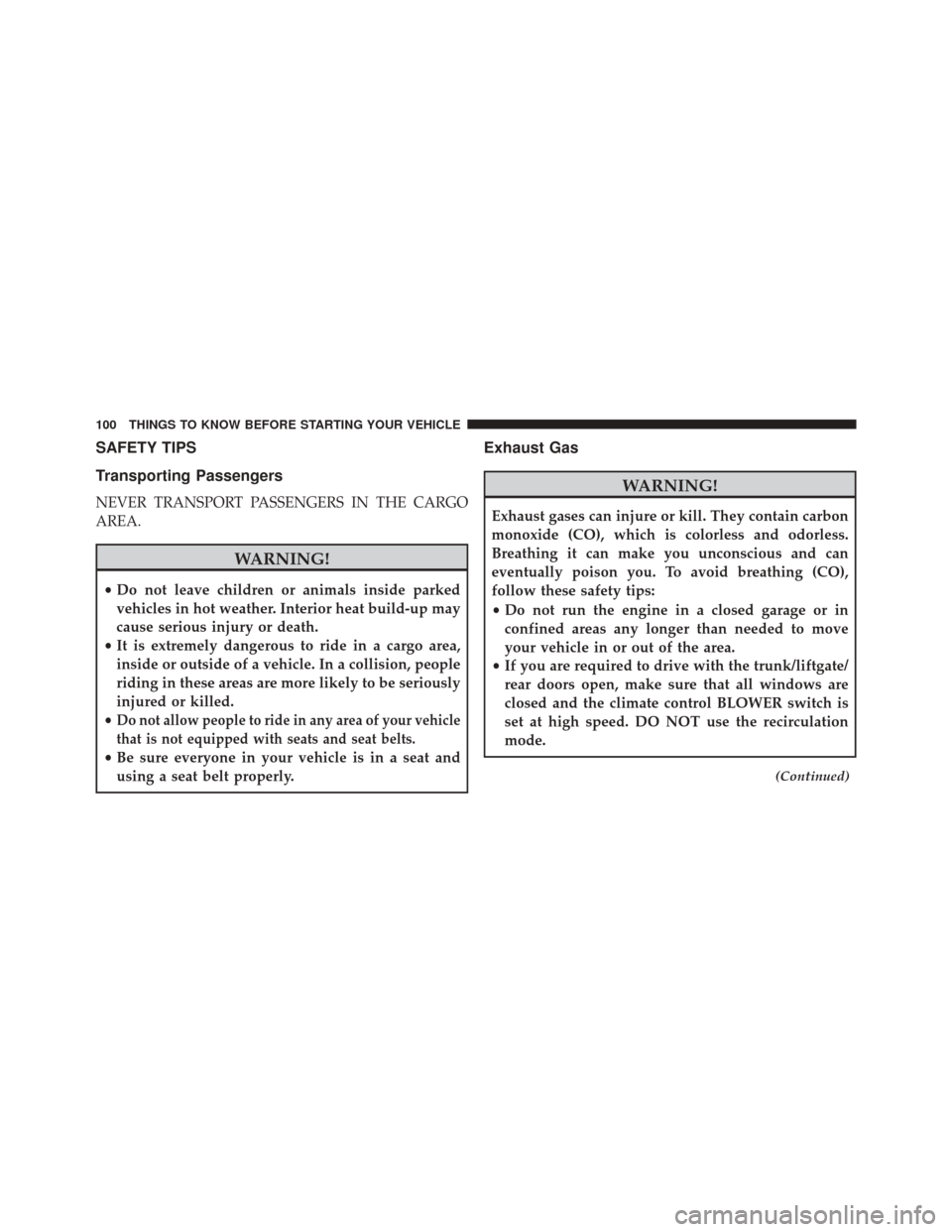
SAFETY TIPS
Transporting Passengers
NEVER TRANSPORT PASSENGERS IN THE CARGO
AREA.
WARNING!
•Do not leave children or animals inside parked
vehicles in hot weather. Interior heat build-up may
cause serious injury or death.
• It is extremely dangerous to ride in a cargo area,
inside or outside of a vehicle. In a collision, people
riding in these areas are more likely to be seriously
injured or killed.
•
Do not allow people to ride in any area of your vehicle
that is not equipped with seats and seat belts.
• Be sure everyone in your vehicle is in a seat and
using a seat belt properly.
Exhaust Gas
WARNING!
Exhaust gases can injure or kill. They contain carbon
monoxide (CO), which is colorless and odorless.
Breathing it can make you unconscious and can
eventually poison you. To avoid breathing (CO),
follow these safety tips:
• Do not run the engine in a closed garage or in
confined areas any longer than needed to move
your vehicle in or out of the area.
• If you are required to drive with the trunk/liftgate/
rear doors open, make sure that all windows are
closed and the climate control BLOWER switch is
set at high speed. DO NOT use the recirculation
mode.
(Continued)
100 THINGS TO KNOW BEFORE STARTING YOUR VEHICLE
Page 103 of 661
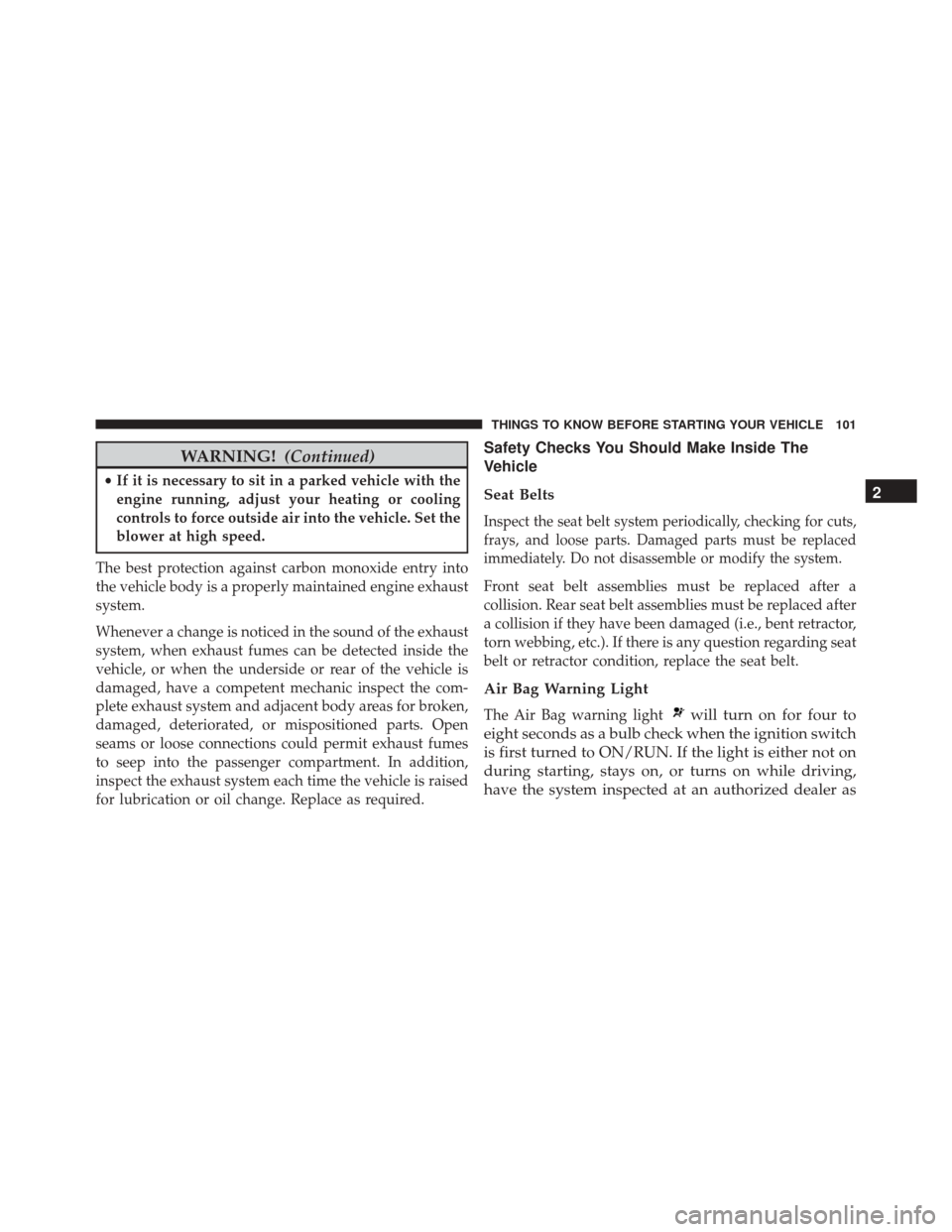
WARNING!(Continued)
•If it is necessary to sit in a parked vehicle with the
engine running, adjust your heating or cooling
controls to force outside air into the vehicle. Set the
blower at high speed.
The best protection against carbon monoxide entry into
the vehicle body is a properly maintained engine exhaust
system.
Whenever a change is noticed in the sound of the exhaust
system, when exhaust fumes can be detected inside the
vehicle, or when the underside or rear of the vehicle is
damaged, have a competent mechanic inspect the com-
plete exhaust system and adjacent body areas for broken,
damaged, deteriorated, or mispositioned parts. Open
seams or loose connections could permit exhaust fumes
to seep into the passenger compartment. In addition,
inspect the exhaust system each time the vehicle is raised
for lubrication or oil change. Replace as required.
Safety Checks You Should Make Inside The
Vehicle
Seat Belts
Inspect the seat belt system periodically, checking for cuts,
frays, and loose parts. Damaged parts must be replaced
immediately. Do not disassemble or modify the system.
Front seat belt assemblies must be replaced after a
collision. Rear seat belt assemblies must be replaced after
a collision if they have been damaged (i.e., bent retractor,
torn webbing, etc.). If there is any question regarding seat
belt or retractor condition, replace the seat belt.
Air Bag Warning Light
The Air Bag warning lightwill turn on for four to
eight seconds as a bulb check when the ignition switch
is first turned to ON/RUN. If the light is either not on
during starting, stays on, or turns on while driving,
have the system inspected at an authorized dealer as 2
THINGS TO KNOW BEFORE STARTING YOUR VEHICLE 101
Page 104 of 661
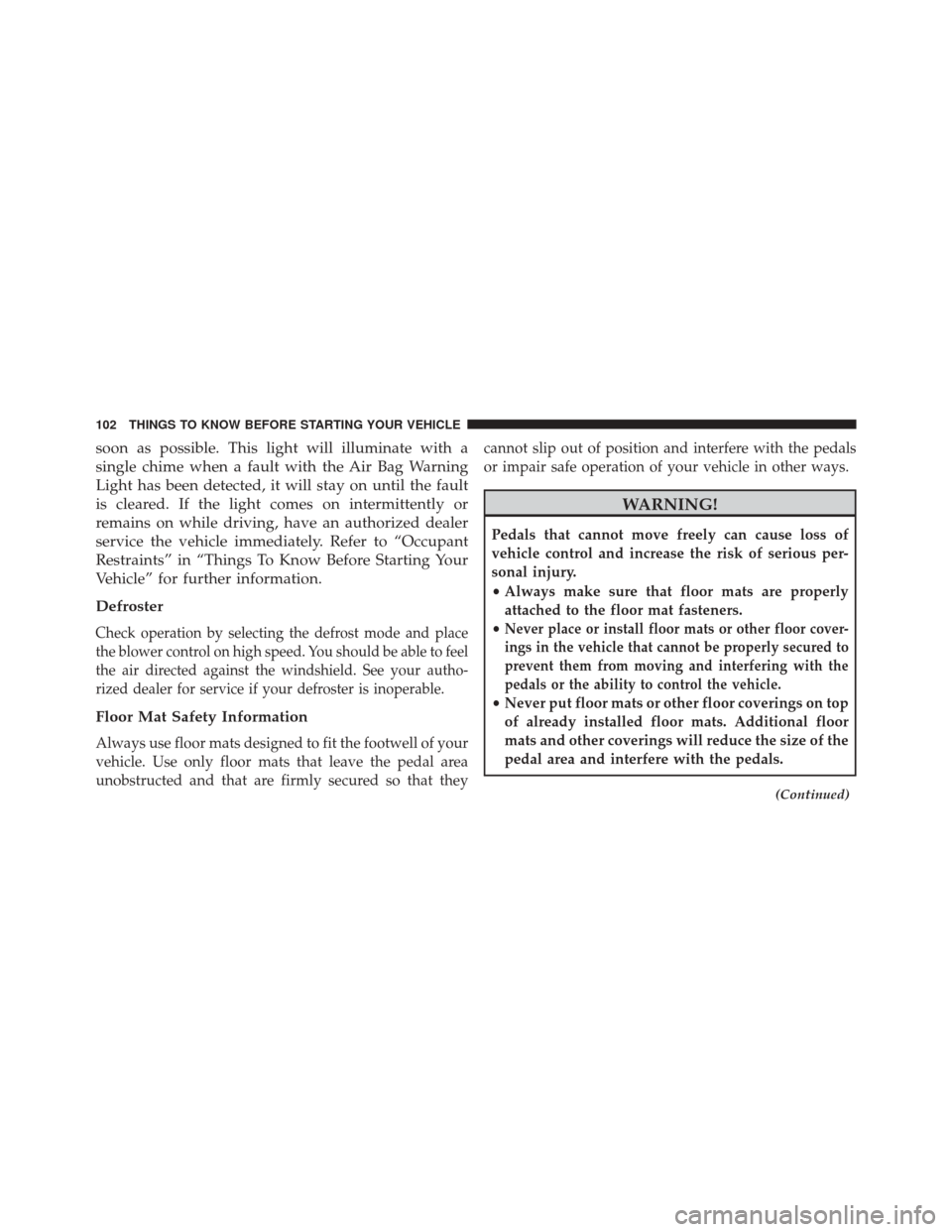
soon as possible. This light will illuminate with a
single chime when a fault with the Air Bag Warning
Light has been detected, it will stay on until the fault
is cleared. If the light comes on intermittently or
remains on while driving, have an authorized dealer
service the vehicle immediately. Refer to “Occupant
Restraints” in “Things To Know Before Starting Your
Vehicle” for further information.
Defroster
Check operation by selecting the defrost mode and place
the blower control on high speed. You should be able to feel
the air directed against the windshield. See your autho-
rized dealer for service if your defroster is inoperable.
Floor Mat Safety Information
Always use floor mats designed to fit the footwell of your
vehicle. Use only floor mats that leave the pedal area
unobstructed and that are firmly secured so that theycannot slip out of position and interfere with the pedals
or impair safe operation of your vehicle in other ways.
WARNING!
Pedals that cannot move freely can cause loss of
vehicle control and increase the risk of serious per-
sonal injury.
•
Always make sure that floor mats are properly
attached to the floor mat fasteners.
•
Never place or install floor mats or other floor cover-
ings in the vehicle that cannot be properly secured to
prevent them from moving and interfering with the
pedals or the ability to control the vehicle.
• Never put floor mats or other floor coverings on top
of already installed floor mats. Additional floor
mats and other coverings will reduce the size of the
pedal area and interfere with the pedals.
(Continued)
102 THINGS TO KNOW BEFORE STARTING YOUR VEHICLE
Page 105 of 661
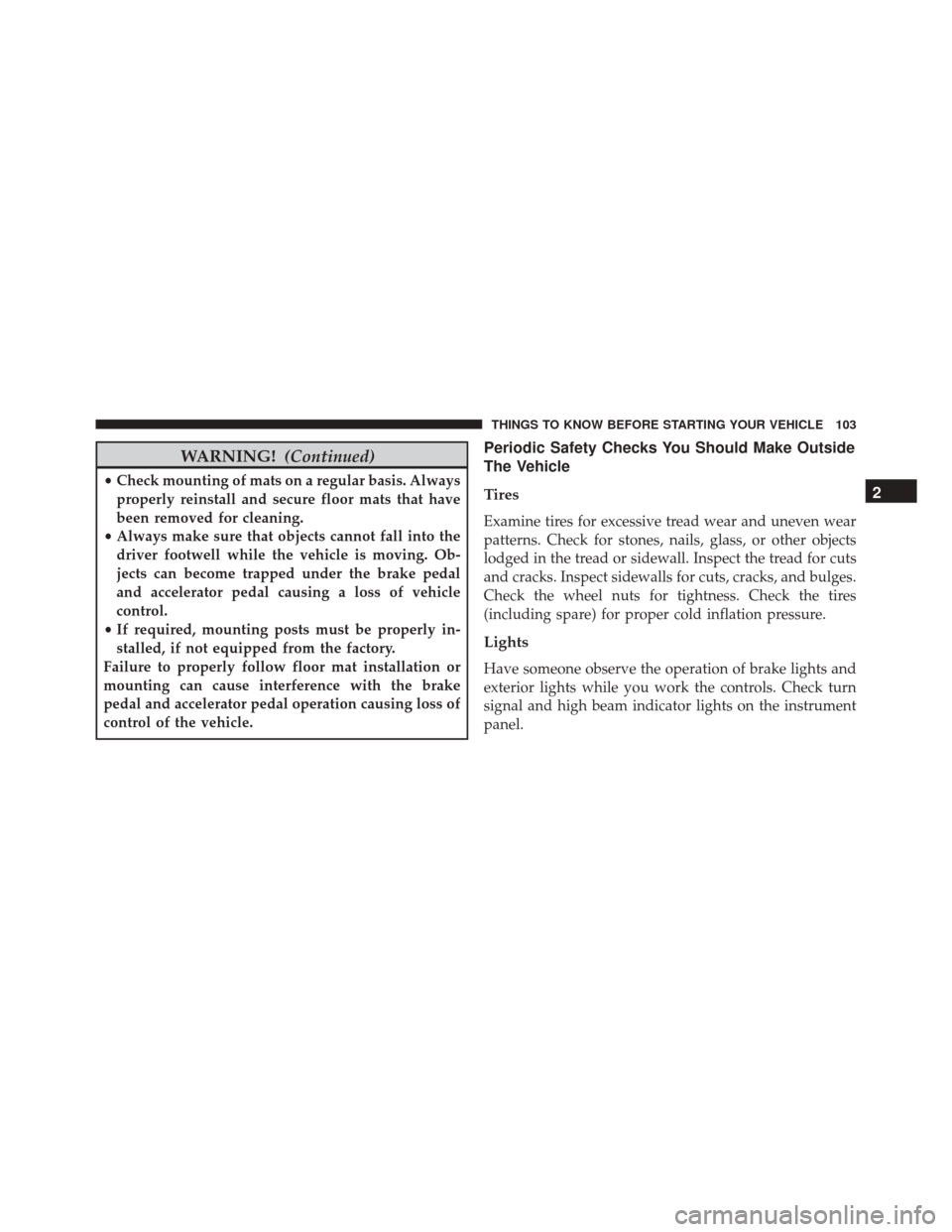
WARNING!(Continued)
•Check mounting of mats on a regular basis. Always
properly reinstall and secure floor mats that have
been removed for cleaning.
• Always make sure that objects cannot fall into the
driver footwell while the vehicle is moving. Ob-
jects can become trapped under the brake pedal
and accelerator pedal causing a loss of vehicle
control.
• If required, mounting posts must be properly in-
stalled, if not equipped from the factory.
Failure to properly follow floor mat installation or
mounting can cause interference with the brake
pedal and accelerator pedal operation causing loss of
control of the vehicle.
Periodic Safety Checks You Should Make Outside
The Vehicle
Tires
Examine tires for excessive tread wear and uneven wear
patterns. Check for stones, nails, glass, or other objects
lodged in the tread or sidewall. Inspect the tread for cuts
and cracks. Inspect sidewalls for cuts, cracks, and bulges.
Check the wheel nuts for tightness. Check the tires
(including spare) for proper cold inflation pressure.
Lights
Have someone observe the operation of brake lights and
exterior lights while you work the controls. Check turn
signal and high beam indicator lights on the instrument
panel.
2
THINGS TO KNOW BEFORE STARTING YOUR VEHICLE 103
Page 110 of 661
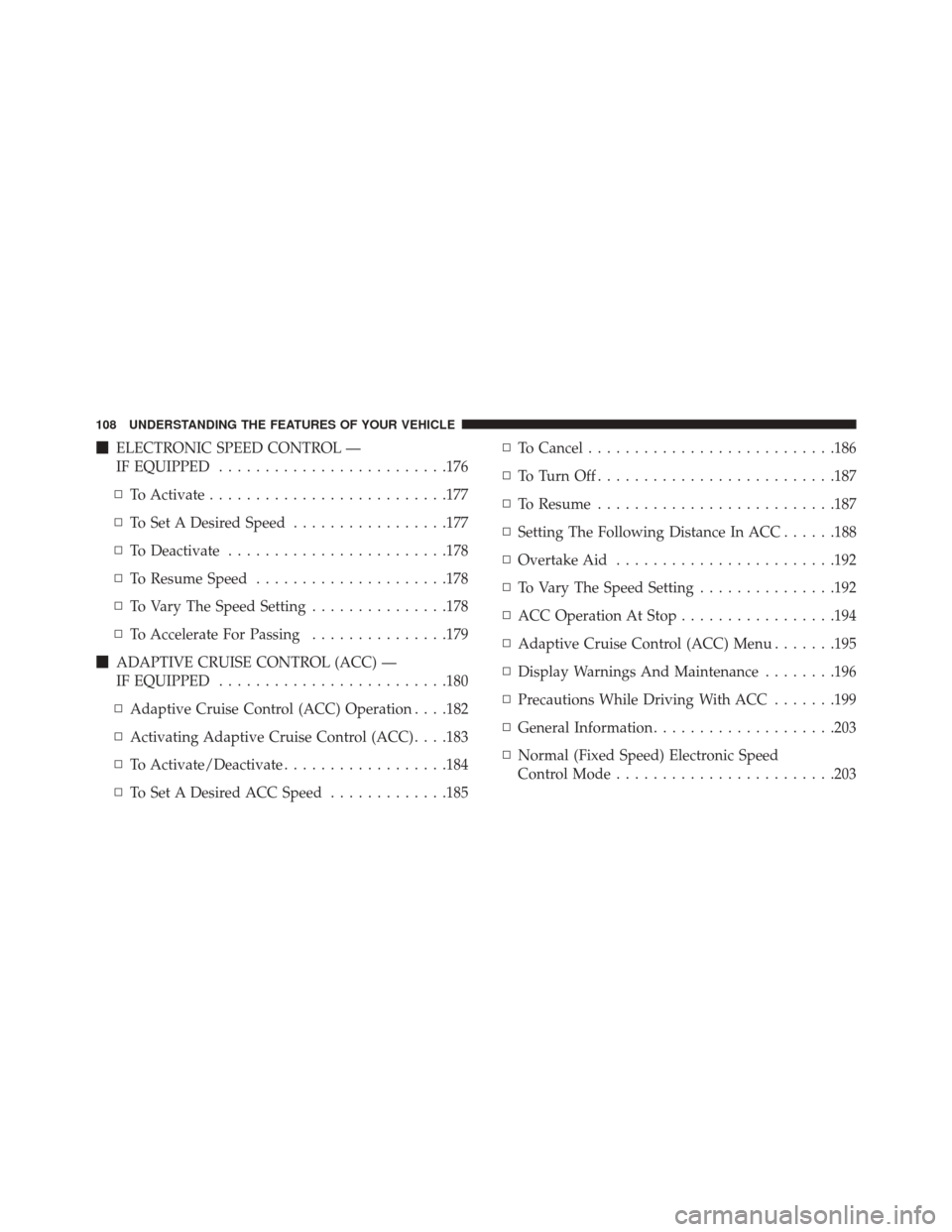
�ELECTRONIC SPEED CONTROL —
IF EQUIPPED ........................ .176
▫ To Activate ......................... .177
▫ To Set A Desired Speed .................177
▫ To Deactivate ....................... .178
▫ To Resume Speed .....................178
▫ To Vary The Speed Setting ...............178
▫ To Accelerate For Passing ...............179
� ADAPTIVE CRUISE CONTROL (ACC) —
IF EQUIPPED ........................ .180
▫ Adaptive Cruise Control (ACC) Operation . . . .182
▫ Activating Adaptive Cruise Control (ACC) . . . .183
▫ To Activate/Deactivate ..................184
▫ To Set A Desired ACC Speed .............185▫
To Cancel .......................... .186
▫ ToTurnOff......................... .187
▫ To Resume ......................... .187
▫ Setting The Following Distance In ACC ......188
▫ Overtake Aid ....................... .192
▫ To Vary The Speed Setting ...............192
▫ ACC Operation At Stop .................194
▫ Adaptive Cruise Control (ACC) Menu .......195
▫ Display Warnings And Maintenance ........196
▫ Precautions While Driving With ACC .......199
▫ General Information ....................203
▫ Normal (Fixed Speed) Electronic Speed
Control Mode ....................... .203
108 UNDERSTANDING THE FEATURES OF YOUR VEHICLE
Page 111 of 661
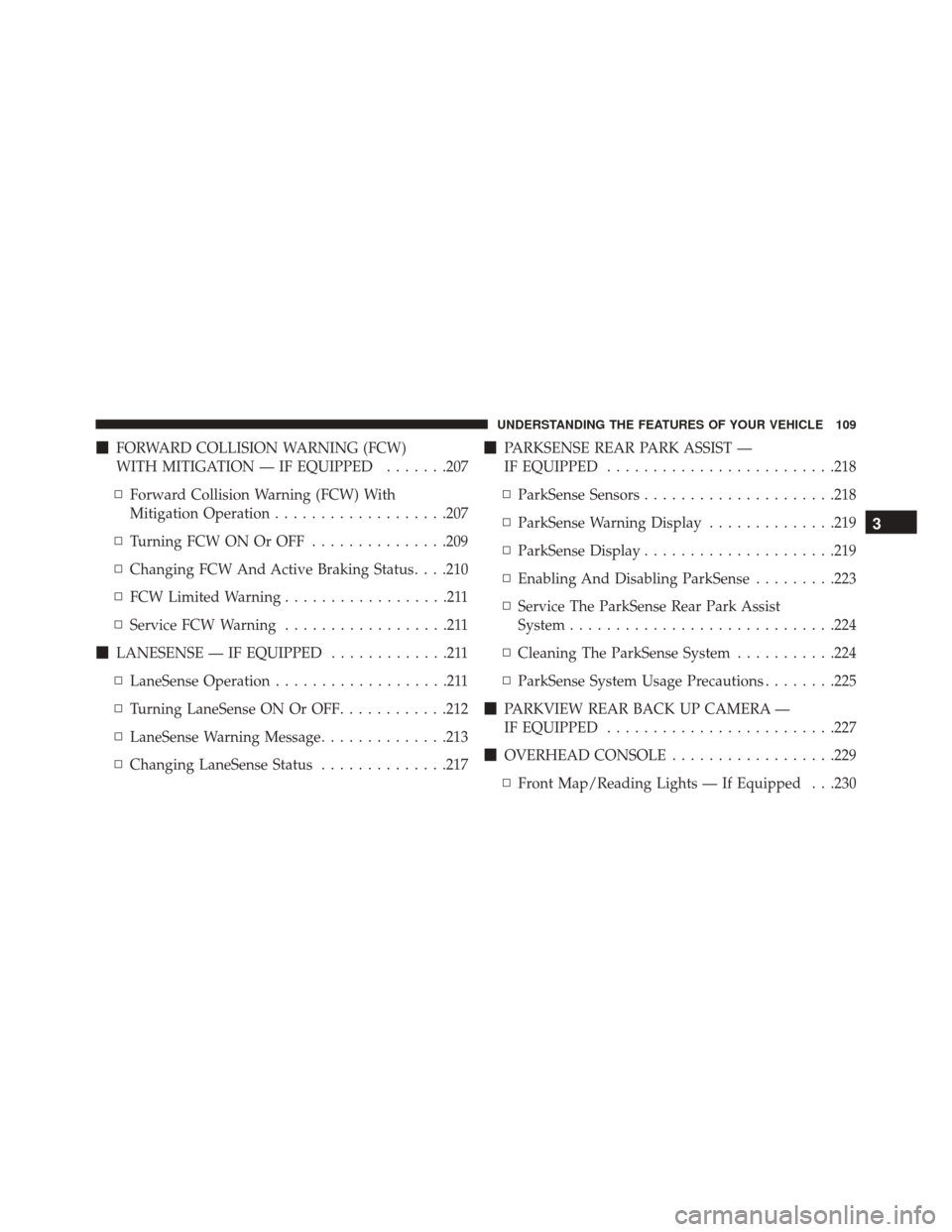
�FORWARD COLLISION WARNING (FCW)
WITH MITIGATION — IF EQUIPPED .......207
▫ Forward Collision Warning (FCW) With
Mitigation Operation ...................207
▫ Turning FCW ON Or OFF ...............209
▫ Changing FCW And Active Braking Status. . . .210
▫ FCW Limited Warning ..................211
▫ Service FCW Warning ..................211
� LANESENSE — IF EQUIPPED .............211
▫ LaneSense Operation ...................211
▫ Turning LaneSense ON Or OFF ............212
▫ LaneSense Warning Message ..............213
▫ Changing LaneSense Status ..............217�
PARKSENSE REAR PARK ASSIST —
IF EQUIPPED ........................ .218
▫ ParkSense Sensors .....................218
▫ ParkSense Warning Display ..............219
▫ ParkSense Display .....................219
▫ Enabling And Disabling ParkSense .........223
▫ Service The ParkSense Rear Park Assist
System ............................ .224
▫ Cleaning The ParkSense System ...........224
▫ ParkSense System Usage Precautions ........225
� PARKVIEW REAR BACK UP CAMERA —
IF EQUIPPED ........................ .227
� OVERHEAD CONSOLE ..................229
▫ Front Map/Reading Lights — If Equipped . . .230
3
UNDERSTANDING THE FEATURES OF YOUR VEHICLE 109